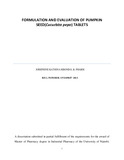| dc.description.abstract | The use of herbal medicines in management of medical conditions has become popular in the
recent years both for preventive and curative purposes. With the increasing prevalence of certain
diseases eg. Benign Prostate Hyperplasia, diabetes, arthritis and the accompanying economic
burden, it is prudent to venture in the development of new safer and inexpensive medicines for
their management. Pumpkin seeds have been used for the management of these and other
medical conditions. The seeds of pumpkin are normally powdered for administration or chewed
whole. This mode of administration poses limitations such as inaccurate dosing due to variation
of measuring devices used. Due to the bulkiness of powders and seeds further makes them
inappropriate to carry especially during travel. The presence of oils in the powders also increases
the possibility of rancidity due to variations in storage conditions of the powders. There is also a
high potential of microbial growth especially when powders are mixed with other food
ingredients for the purpose of making porridge. Since this powders are subjected to high
temperatures during the process of cooking, there is therefore a high likelihood of the active
ingredients getting inactivated by high temperatures used. Powders are also prone to adulteration
hence formulation into a tablet decreases this possibility. In the present research work, tablets of
pumpkin seed were prepared by the wet granulation technique. The purpose of this was to
formulate a suitable solid dosage form of whole pumpkin seed that may address the above
mentioned limitations. Pre-formulation studies indicated that the powder did not have free
flowing capacity and hence wet granulation method was adopted. The tablets were evaluated for
hardness, weight variation, friability, and disintegration time. From the results, it was concluded
that tablets can be made from pumpkin seed powder which will improve effectiveness and
patient compliance.
Pumpkin seeds were obtained from Nakumatt Mega supermarket in Kenya, other excipients were
obtained from Department of Pharmaceutics and Pharmacy Practice Laboratory. Three
formulations (F1-F3) in which the choice of binder and disintegrant were varied were prepared
F1 contained corn starch 10% binder and crosscarmellose 5% disintegrant. F2 contained sucrose
10% binder and polyvinylpyrollidone 5% disintegrant. F3 contained polyvinyl pyrollidone 10%
binder and cornstarch 5% disintegrant. (% w/w of total tablet weight)
The equipment used included Single punch tablet compression machine (Erweka, electric type,
Germany) Disintegration Tester Machine (Erweka ZT3, GmbH Heusenstamm, Germany)
Friability Tester machine (Erweka, Heusenstamm, type TA3R, German) and tablet Hardness
Tester ( Scheuniger, electric type, Germany ), Weighing balance (Shimadzu), Vernier calipers.
From the preformulation studies, C.pepo powder had a Db of 0.35 and Dt of 0.56. The Hausner
ratio obtained was 1.6. The compressibility index was very poor 38%. The angle of repose was
34. Tablets of all formulations passed the uniformity of weight test. Two formulations passed the
Friability and hardness test (F1 and F2) while formulation F3 failed both tests. Only one
formulation F1 displayed good disintegration time profile of 14 minutes. Both F2 and F3
displayed prolonged disintegration time more than 15 minutes recommended for uncoated
tablets. In conclusion this study indicated that uncoated tablets of pumpkin seeds can be
formulated using cornstarch singly as a binder and crosscarmellose as disintegrant. In the case of
sucrose binder further research is recommended to optimize the disintegration time. The general
appearance of tablets was good for all formulations. Further research is also recommended to
establish clinical data for treatment with C. pepo tablets before scale up for commercial
production can occur. | en_US |
| dc.description.department | a
Department of Psychiatry, University of Nairobi, ; bDepartment of Mental Health, School of Medicine,
Moi University, Eldoret, Kenya | |

